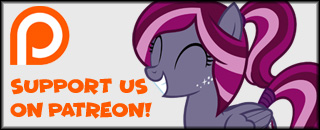 |
| Yeah sure, I'm buying these for my sister. That's my excuse. |
It's odd picking up a pony toy at Target or Walmart for the first time and realizing that the splash of pink and purple that you're holding is something that affects so many people's lives. Meanwhile, these toys are a number to the store that you're buying it from, a singular sale. But what would happen if the sale was not the store's bottom line? The intricacies that come with stocking shelves and putting one item next to another in order to nudge that one extra sale must be infinite, so why disrupt it? In a recent press release, Target has announced that they are going to get rid of gender-based signage in their stores, effective over the next few months. This basically means that the MLP aisle in Target is not going to be labeled with "girls" signs, along with the "Barbie" toys and etc.
What exactly does this mean for the fandom that has proclaimed over the years that MLP is more than just a revamped show for little girls? Is it a "win" for us? Is this the start of a phenomenon that will touch other stores? Finally, will this have an impact on Hasbro's design choices for their toys? Let's discuss after the break.
Disclaimer: My apologies in advance, but this editorial is going to be more about the fandom than the ponies this time around. Seth suggested that this topic should be an editorial and I think this is an interesting discussion point. Also the opinions discussed in this editorial are only the opinions of myself, not Equestria Daily or anyone else. I will remain as objective as possible but do be aware that complete objectivity is impossible in this line of work.
This might be the understatement of the year, but gender politics is a hot button issue in America right now. Making any sort of decision that could be politically driven or otherwise assumed to be so is dangerous, especially in a climate where extremism seems to be the name of the game. A simple scroll through the comments section of Target's press release can prove that, considering there's a lot of assumptions, negativity, and flat out aggression among the raves.
I don't have a dog in the gender politics battle. I'd rather watch "Games Ponies Play" on an endless loop than talk about such a subject. I feel uncomfortable merely bringing it up in this editorial, since colorful pastel horses is an easier subject to talk about. Along with that, no one would notice if I never brought Target's choice up. But then I think about all the confusion that I received from my friends and family when I first talked about MLP to them. It's always the same first question: "Isn't My Little Pony a girl's show?"
It doesn't matter how long I debate the excellence of the show's episodes, or how long I explain that Lauren Faust's original intention for MLP was to make a show that everyone could enjoy. I'm still given that question, as if it's a trick that cannot be answered. The cover of the show is immediately judged, and the subject closes. Gender-based labeling enforces those types of rhetorical questions. Those who ask that question were never curious about the phenomenon that happened with pony or even Star Trek decades ago.
Now they have a reason to be curious. With Target's choice, this archaic social norm of treating MLP toys as "girl's" toys is being challenged. Obviously, bronies are not the reason that Target is changing their labels. But within our fandom, MLP is not strictly a "girl's" show. While that may be the target demographic, the numerous nods to both the fandom and adults (Doctor Whooves and "the Big Lebowski" ponies for example) clarifies Faust's intention.
Target is essentially agreeing with the fandom. Sure, "My Little Pony" has colorful pastel horses that are aesthetically pleasing to girls. Princess Celestia's non-canon toy color points to this. But both boys and girls could feel empathy towards the character's situations. Anyone could understand a moment in their life where they had too much on their plate ("Applebuck Season"), or felt pressured to be someone that they aren't in order to impress another ("Simple Ways"). We recently posted an article about this exact point.
What does this mean for the fandom? Well, to put it simply, we now have a company that is "on our side", for lack of a better phrase. The entire idea behind our fandom is that we are allowed to like things that others would dismiss as "girly", because the "girly" label is loaded to begin with. "Girly" is code among the television and movie outlets to be simple, dumb, or one-note. But we know as a fandom that what a show looks like is not what the show contains.
Our fandom is an example of a phenomenon that was ahead of the times. An MLP toy is only perceived to be "girly" because of the social stigma surrounding colors and shapes. Along with that, a large amount of money is funneled into research to make sure that the correct shade of pink or the most eye-grabbing visual appears on the toy box. These all factor into the company's decision to (inadvertently or otherwise) drive these social stigmas to make sure that their toy is bought over the "Barbie" or "Monster High" toys.
Even with Hasbro's decision to fill up the MLP aisle with a myriad of pink, purple, and rainbows, we already have examples of pony merchandise that are breaking this standard. Nearly all the merchandise sold in Hot Topic is lacking unnecessary pink and purple shades, because it's aimed towards us bronies, or possibly everyone. An increasing amount of pony merchandise is taking this route, from the new Mystery Minis figurines to the vinyl collectibles.
What does this mean for Hasbro's future toy designs? I don't know, but I can bet that Target's decision has definitely been brought up at Hasbro's headquarters. To stay alive in marketing is to stay ahead of the game. Target may not have shifted the game in any noticeable way, but it has definitely "planted the plunderseeds" for the future. It's possible that Hasbro's future toy designs will have a little less pink and white than today's designs. It's also possible that nothing is going to change, and Target might roll back their choice in the coming years if it makes shopping more confusing and unfavorable towards its customers. However I have faith that Target's choice is the beginning of something huge. Whether it's the discussion of the social stigmas surrounding children's toys, or an outright challenge to those by one toy company at a time, I can't wait for what happens next.
What do you all think? Is the elimination of gender-based labeling a "win" for the type of mantra that the fandom has been preaching since the beginning? Will other toy companies follow alongside Target's choice and change their marketing strategies as a result? Or is this an isolated incident that we will all forget within the coming months? Let us know in the comments! Thank you very much for reading this editorial. I will see you all next week!
Target is essentially agreeing with the fandom. Sure, "My Little Pony" has colorful pastel horses that are aesthetically pleasing to girls. Princess Celestia's non-canon toy color points to this. But both boys and girls could feel empathy towards the character's situations. Anyone could understand a moment in their life where they had too much on their plate ("Applebuck Season"), or felt pressured to be someone that they aren't in order to impress another ("Simple Ways"). We recently posted an article about this exact point.
What does this mean for the fandom? Well, to put it simply, we now have a company that is "on our side", for lack of a better phrase. The entire idea behind our fandom is that we are allowed to like things that others would dismiss as "girly", because the "girly" label is loaded to begin with. "Girly" is code among the television and movie outlets to be simple, dumb, or one-note. But we know as a fandom that what a show looks like is not what the show contains.
Our fandom is an example of a phenomenon that was ahead of the times. An MLP toy is only perceived to be "girly" because of the social stigma surrounding colors and shapes. Along with that, a large amount of money is funneled into research to make sure that the correct shade of pink or the most eye-grabbing visual appears on the toy box. These all factor into the company's decision to (inadvertently or otherwise) drive these social stigmas to make sure that their toy is bought over the "Barbie" or "Monster High" toys.
Even with Hasbro's decision to fill up the MLP aisle with a myriad of pink, purple, and rainbows, we already have examples of pony merchandise that are breaking this standard. Nearly all the merchandise sold in Hot Topic is lacking unnecessary pink and purple shades, because it's aimed towards us bronies, or possibly everyone. An increasing amount of pony merchandise is taking this route, from the new Mystery Minis figurines to the vinyl collectibles.
What does this mean for Hasbro's future toy designs? I don't know, but I can bet that Target's decision has definitely been brought up at Hasbro's headquarters. To stay alive in marketing is to stay ahead of the game. Target may not have shifted the game in any noticeable way, but it has definitely "planted the plunderseeds" for the future. It's possible that Hasbro's future toy designs will have a little less pink and white than today's designs. It's also possible that nothing is going to change, and Target might roll back their choice in the coming years if it makes shopping more confusing and unfavorable towards its customers. However I have faith that Target's choice is the beginning of something huge. Whether it's the discussion of the social stigmas surrounding children's toys, or an outright challenge to those by one toy company at a time, I can't wait for what happens next.
What do you all think? Is the elimination of gender-based labeling a "win" for the type of mantra that the fandom has been preaching since the beginning? Will other toy companies follow alongside Target's choice and change their marketing strategies as a result? Or is this an isolated incident that we will all forget within the coming months? Let us know in the comments! Thank you very much for reading this editorial. I will see you all next week!







































